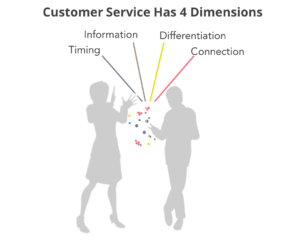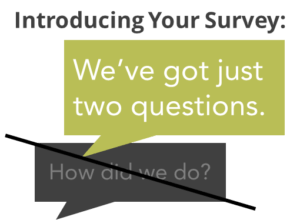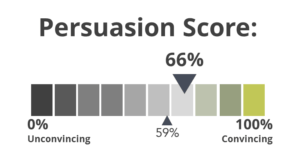Chat: Could It Be Your Ultimate Conversion Machine?
Chat can be designed to show up when customers need a recommendation. This makes it a powerful tool to increase conversions.
Are you looking to get more from your website? Who isn’t? But perhaps you’re nearing the point of diminishing returns and it’s time to turn to customer service.
Customer service includes many types of interaction: in-person, email, social, phone, and chat. But for the web, it’s chat that confers the most advantages:
- It’s inexpensive, at least compared to phone-based customer service.
- It’s proactive (unlike social media which is inherently reactive—you wait for customers’ problems, and then scramble to fix them).
- It’s immediate (unlike email), meaning customers prefer it.
Plus, chat can be designed to show up just when customers need a recommendation or seem to be questioning their purchase decisions. This makes chat a powerful tool when you’re looking to increase conversions.
Chat is a powerful tool when you’re looking to increase conversions. Share on XHowever, even if chat shows up at the perfect time, it only boosts conversion when your associates know what to say—and how to say it. In other words, when associates provide great customer service.
But just because conversion is the goal does not mean your sales and marketing teams should take over. When customers look to chat for information, being overly sales-focused drives them away. Yes, a bump in sales is the end-goal, but associates need to provide great customer service first.
Great Customer Service First
A quick google on ‘customer service chat transcripts’ comes up with: “a nightmarish Amazon customer support chat” and “terrible customer service chat with Comcast.”
Lesson learned? When chats go south, customers not only rant, they have the transcript to show how they were wronged and they’re eager to share those chats with the world.
Enjoying this article?
Subscribe to our newsletter, Good Question, to get insights like this sent straight to your inbox every week.
To help you deliver the kind of great customer service that will turn chat into your conversion machine, I have 10 tips. They apply whether you’re launching chat, or looking to optimize the chat you already have. Don’t just bookmark them, heed them, because chat, like the rest of your customer service, should be positive for your customers and profitable for you!
Chat, like the rest of your customer service, should be positive for your customers Share on XBy the way, you’ll see examples pulled from a wide range of industries, from investment services to ophthalmology. We do extensive customer service evaluations which gives me thousands of examples to pull from. Say hello if you’d like me to send you examples relevant to your particular industry.
The 4 Dimensions of Customer Service

Providing great customer service that drives conversion requires understanding the 4 dimensions of customer service:
- Timing – these are the pacing aspects of customer service, how long things take and whether the customer is likely to feel their time is valued, a prerequisite for chat to function as a conversion machine.
- Connection – this is about showing the customer you’re listening. When you want customers to take next steps, it’s a lot easier when the customer feels you care.
- Information – timing and connection mean nothing if you provide bogus or confusing answers. For customers to take the next step, they need answers that are proactive, accurate, and clear.
- Differentiation – no matter how good you are, customers are always shopping around. That’s why it’s important for each chat to demonstrate how you stand apart from the competition. This can be a simple sentence or two that facilitates conversion by reinforcing your expertise.
Each dimension requires specific customer service skills. For instance, acing timing is about keeping queues to a minimum while managing multiple chats as they come in. On the other hand, connection requires the ability to slow down and show active listening through the written word.
Tips to Succeed with Each Customer Service Dimension
Timing
- TIP #1: Set expectations and meet them: when you indicate that the wait time for chat is 1 minute, make sure that’s 1 minute—or less. This is critical for conversion, because if a customer gets stuck waiting longer than you’ve promised, they may take that time to start searching for another company.
- TIP #2: Customers treat chat as similar to an in-person conversation (more about this in TIP #3) and so associates need to write in near real-time. Never leave a customer to ask “are you there?” If a delay is unavoidable, let the customer know you need another minute to research the answer.
Connection
- TIP #3: Skip the empty questions. Customers are chatting for answers, and while chat can be conversational, connecting means getting to the point. “How are you doing today?” and other space-filler questions are usually read as tedious hurdles the customer must endure, rather than niceties the customer enjoys.
- TIP #4: Be specific and reference the customer’s situation immediately. If the intake form shows why the customer is chatting, don’t ask the customer to repeat themselves; instead move into relevant, clarifying questions that show listening.
- TIP #5: Use the customer’s name; it’s a small way to show the customer you care and are focused on them.
Information
- TIP #6: Validate with social proof. Show the customer that others have made a similar decision and have been happy with it. For example, a home improvement retailer could explain to an uncertain shopper that “in the product reviews, customers rave about the ergonomics and versatility of this particular lawn mower.”
- TIP #7: Include a call to action. Suggesting an easy next step is one of the most important aspects of conversion. For example, always provide links to the products/services referenced. This way, if you’ve been persuasive, it’s simple for the customer to click and move ahead.
- TIP #8: If the customer doesn’t seem rushed, share facts the customer might not have thought to ask about. This could include information about how to install the product or how to get further support with set-up and installation.
Differentiation
- TIP #9: Cite facts and statistics that show your company is the expert. For example, an insurance company might say: “For five years in a row, we’ve been rated the best home insurance agency in Florida.” Or a sunglasses retailer might add: “Our sunglasses go through a 30-point quality assurance checklist—they’re tested to survive the worst mountain bike wipeouts.”
- TIP #10: When customers are engaged, go the extra step, and add value. For instance, that same sunglasses retailer might share: “one of the best ways to keep your sunglasses at their peak is to keep them off the dashboard—because as your car heats up, your lenses gradually delaminate.”
Not Measuring It? Then You’re Not Managing It
Metrics are crucial to effective management. But, conversion rate is just one of the metrics you need. In fact, for customer service, it’s not the most important metric to track. That’s because conversion rate is an outcome metric, not a metric that sheds light on what’s encouraging—or discouraging—customers from taking a next step.
To understand root causes and to mastermind chat, customer service needs specific details about problem areas and the quality of communication. There are two ways to capture these kinds of metrics: customer satisfaction surveys and customer service evaluations.
Customer Satisfaction Surveys
The most common way to measure your success with chat is with a post-chat customer satisfaction survey. While popular, surveys are limited because customers don’t think about their chats with you that much. Besides, customers don’t know what answers you could have provided. Nevertheless, if your customer satisfaction survey is good you’ll have a Customer Perception Score along with some insight into your customers’ needs, priorities, and expectations.
If you are going to use a survey, the best time is right after the chat, while the memory of it is fresh.

Refrain from asking questions like “how did we do?” and instead state that you have just two questions. Keeping your customer satisfaction survey short tends to increase response rate, and a decent response rate often means more representative data. Here are a few other tips for your surveys:
- Ask one open ended question, and use a scientific coding technique to uncover emergent themes from your customers’ comments.
- Make sure your questions aren’t leading. For example, “how satisfied were you…?” assumes the customer is at least somewhat satisfied in the first place. Or, “how likely are you to recommend us to….” assumes the customer is at least somewhat likely to recommend.
- Ask questions that customers can answer. Don’t ask: “Did we give you the best possible answer?” The customer doesn’t know what they don’t know. Instead ask “Did this answer help you to reach a decision?”
Customer Service Evaluations

The second, more effective, way to measure your chat success is with evaluations based on statistically-valid samples of your customer interactions. The right kind of customer service evaluation will show you how you’re doing with specific communication elements, and will give you a Persuasion Score, the key metric to track for customer service conversion.
The elements that comprise Persuasion Score depend on the industry you’re in, the products/services you provide, and the next steps you want customers to take.
For example, consider an investment services company that uses chat to help Registered Investment Advisors open trade accounts. In this case, Persuasion Score is based on: the clarity and correctness of answers, the sharing of additional resources, plus the presence of an open-ended question such as: “what else can I answer?”
In this market, for these customers, Persuasion Score is based on information quality because it takes a depth of relevant information to convince a browser to take that next step.
Let’s look at a different example; an ophthalmology practice uses chat to schedule face-to-face consultations. Here, the elements that go into Persuasion Score include: providing a compelling invitation to meet with one of the doctors, and sharing a statement that shows how the practice stands apart from the competition.
Chat will boost conversion on your website, but only if your customer service is disciplined and measured. Share on XI hope these tips move you toward great customer service and a higher conversion rate. And by all means, go ahead and email me one of your chat transcripts. I’ll tell you if it’s conversion oriented. If it’s not, I’ll give you a few ideas about how to make your chat more persuasive. Upward! Onward! Toward great chat!

About the Author
Martha Brooke
Martha Brooke is Chief Customer Experience Analyst & Founder at Interaction Metrics. Interaction Metrics dramatically boosts the value of customer feedback programs, customer service evaluations, and customer service skills coaching. Say hello to request an e-book about cx metrics or to set a time for a free, 25-minute MetricsLAB. Connect with Martha on Twitter.